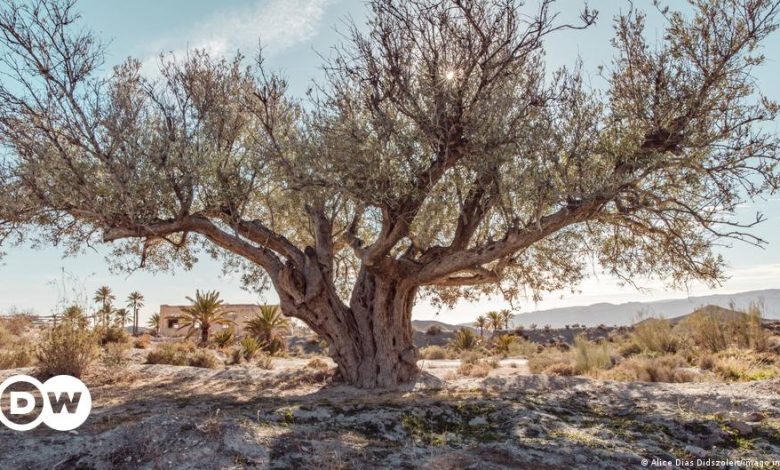
The real stress for Spain’s olive tree begins in autumn. Olive groves can tolerate long periods of drought from April to September and sudden frosts in November.
But if trees lose their fruit between October and February, due to strong shaking by the harvesting machine and are pruned directly, “then they suffer,” Ruben Gomez, who manages production and harvest at Garcia de la Cruz agricultural firm, told DW.
“So far they have been allowed to rest for a year, but that will change soon,” he added.
Harvesting is currently underway on his rocky plantation near Toledo, southwest of the Spanish capital, Madrid. Here, unlike in the olive mecca of Jaen in southern Andalusia, the soil is not a beautiful reddish brown, but rather a boring gray.
Gomez’s people have been active in the field since the beginning of October. A tractor with a special device grabs each tree trunk and shakes it, at the same time men hit the branches with long sticks.
Depending on the degree of ripeness, green, pink or black olives rain down on the black net stretched out under the tree.
“It is an enormous stress for the tree. The vibration should therefore not last longer than 15 seconds and the hitting should be done carefully,” explains Gomez.
The drought and its consequences
As a rule, each tree produces around 40 kilos (88 pounds) of fruit. However, a historic drought in some regions of Spain is leading to very poor harvests in many areas.
The olive tree doesn’t need too much water, but during flowering in May, it can’t stand too much heat. Last summer, that’s exactly what happened, sparking a skyrocketing in prices for olive oil in recent months.
Garcia de la Cruz, on the other hand, is one of the few producers in Spain who have ensured their trees bear fruit every year, thanks to a gentle harvesting technique and the partial irrigation of their plantation.
Around a quarter of the plantation is now artificially irrigated, with probes measuring exactly when and how much water the tree needs.
Spain sets olive oil price
The Spanish’s expertise in growing, and squeezing olive juice is now in global demand. Spain’s olive oil is still considered among the best — and the country produces the largest volume.
World market prices are decided in the olive mecca of Jaen, where the entire landscape is covered with olive groves. The producer price there is currently around €8 ($6.63) a liter. In the store, a bottle of olive oil costs a full €10 — more than double what it was two years ago.
“Despite this [price increase], demand on the global market remains high,” said Gomez, who sees an enormous opportunity in the current situation.
Spain has now not only set up olive plantations of their successful varieties in the United States, but is also supplying tons of unpackaged olive oil to their main competitor Italy.
Some industry experts think the rise in exports, now up to half of Spain’s olive oil goes overseas, has led to higher prices for domestic consumers.
“Spain should therefore manage its supply chain itself,” Antonio Canadilla, president of the Cooperativa San Sebastian-Aceites Umbrion cooperative, told DW.
He noted that the Italians are selling Spanish oil under their own brands, so many consumers now believe that the Italians and not the Spanish are the market leaders in the olive business.
“But despite this, none of our comrades want to invest in marketing and sales,” he added.
Olive oil: a new luxury item
Another problem is that Spain’s system of agricultural cooperatives is often characterized by outdated business structures. They still control 80% of the market.
Despite very few women being involved in the olive oil market, García de la Cruz is a bit of a trailblazer. The company was founded 150 years ago by a woman and is one of the few olive oil producers in Spain that completely controls its supply chain, guaranteeing not only high margins but also more competitive prices.
The firm exports almost all of its production to Japan and the US, where liter bottles have been sold for years at twice the price as at home.
In contrast, over the past two years, crop failures and structural problems in Spain’s olive market have now exacerbated inflation across the Spanish food chain, so olive oil has become a luxury item.
According to a study by the Autonomous University of Madrid, food prices in Spain rose by 15.7% last year. This year, the inflation rate remains at roughly the same level.
As a result, Spaniards are already changing their buying choices and the cooperative Canadilla predicts that consumption of olive oil nationally will fall by 38% this year alone.
Outdated sales structure
Economist Rafael Pampillon from the Madrid University of San Pablo CEU is convinced that speculation in the domestic market is helping prices higher.
“But it is also a fact that olive oil in France and Portugal is significantly cheaper than here,” he told DW.
While the climate may be better in those two countries, demand in Spain has always been high as the Spanish see olive oil not as a gourmet product, but as a staple food.
To reduce price pressures, some grocery chains such as the Galician Froiz or Mercadona have stepped up imports of cheaper olive oil from Portugal. But they can only do this because of already established purchasing channels in Portugal, Pampollon said.
“Supply chains cannot simply be changed overnight; that costs a lot of money,” he told DW, adding that he does not see food prices in Spain falling anytime soon.
Waiting for 2025
The olive tree remains an ideal shrub for Spain, even though the country’s landscape is suffering from climate change.
“The olive tree only needs rainwater and can endure droughts,” Jose Maria Tarujuelo Martin-Benito, director of the Water Institute of Castile-La Mancha, told DW. “There are trees that have been in Spain for several hundred years.”
He believes that Spain’s rural water shortages can be solved through technology and therefore no reduction in olive production is necessary. He is working on solutions to boost productivity without further polluting the environment.
Enrique García-Tenorio, founder of the Denomination of Origin (DO) for olive oil from the Montes de Toledo area predicts that prices will come down in 2025, helping to stabilize the domestic market.
He told DW that a liter of olive oil would then cost between €3-4 euros in the store.
This article was originally published in German.




